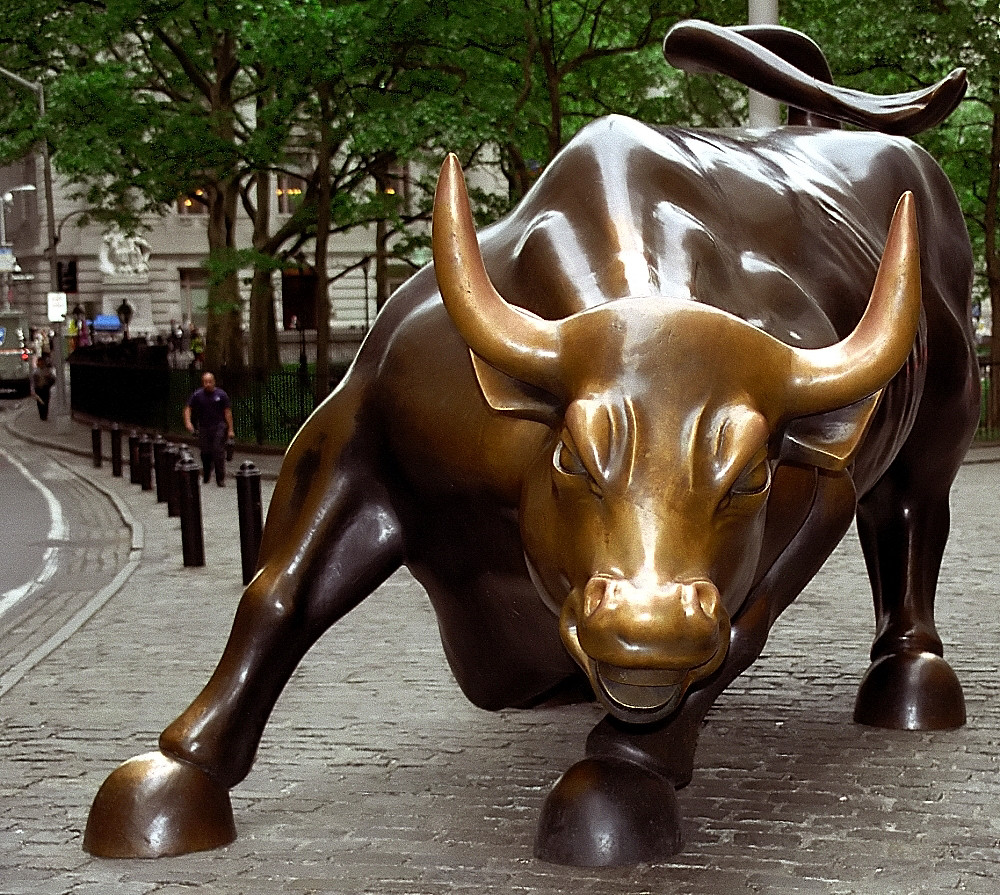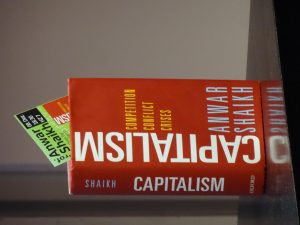Milton's Myth #3: Free Enterprise is Efficient
✑ ROBIN HAHNEL | ± 6 minutes
Milton Friedman said free enterprise promotes efficiency. But the quest for profits can drive firms to choose technologies which reduce efficiency or are contrary to the social interest. (All of Milton's myths here).
Monopoly and oligopolistic markets not only yield static inefficiencies by restricting supply to drive up market price, they promote dynamic inefficiencies as well. Examples of large companies conspiring to suppress technological innovations because it would depreciate their fixed capital, or because it would reduce opportunities for repeated sales because a product lasted longer are legion. While this cause of technological inefficiency in real capitalist economies riddled with non- competitive market structures is important, I concentrate below on a more subtle problem, namely that even when markets are competitive, capitalists will often make socially counterproductive choices of technology.
Biased Price Signals
In Chapter 4 [of The ABC's of Political Economy: A Modern Approach] we discovered that externalities lead to market prices that do not accurately reflect true social costs and benefits. Since capitalists understandably use market prices, not true social costs, when deciding if a new technology is cost reducing, inaccuracies due to external effects can lead to socially counterproductive decisions regarding technologies. For example, our current price system puts a zero price on carbon emissions despite the fact that the EPA says the social cost of carbon is at least $12 per metric ton released and may be as high as $109. As a result we not only produce far too much of our energy from fossil fuels and far too little from renewable sources, but private funding for research to improve our ability to find and burn fossil fuels has been too plentiful, while private funding for research to improve solar panels and wind turbines has been too meager. The Sraffa model of price and income determination in Chapter 5 reveals a completely different reason prices in capitalism are biased in a way that leads profit-maximizing capitalists to make inefficient choices regarding technology. The higher the rate of profit in the economy, and the lower the wage rate, the more likely it is that capitalists will implement new capital-saving, labor-using technologies that are profitable but socially inefficient, and reject new capital-using, labor-saving technologies that are socially efficient but unprofitable. In sum, the greater the prevalence and magnitude of external effects, and the greater the bargaining power of capital over labor, the more likely the price system will provide false signals leading to socially counterproductive choices of technologies.
Conflict Theory of the Firm
The “conflict theory of the firm” explains why profit maximization requires capitalists to choose less efficient technologies if more efficient technologies lower their bargaining power over their employees sufficiently. The logic reviewed informally here is illustrated formally in the application of model 5.2, The Price of Power Game, to the conflict theory of the firm in Chapter 5. There is an inherent conflict of interest between employers and employees over how high or low the wage will be, and how much effort employees will have to exert for that wage. If we define the real wage in terms of dollars of compensation per unit of effort expended this reduces to a struggle over the real wage. For the most part employers are free to choose among alternative technologies available and free to establish whatever internal personnel policies they wish. Or at least, employers have considerable discretion in these areas. Political economists from the conflict school point out that it would be irrational for employers to consider the impact of technological choices and personnel policies on productivity only when these choices also affect employers’ bargaining power vis-à-vis their employees. Since profits depend not only on the size of net output, but also on how net output is divided between wages and profits, rational employers will consider how their choices affect both the size and distribution of the firm’s net output.
Suppose technology A is slightly less productive than technology B, but technology A substantially reduces employees’ bargaining power while technology B increases the employer’s bargaining power significantly. A profit-maximizing employer would have no choice but to opt for the less productive technology A. For example, consider automobile manufactures’ choice between assembly line versus work team technologies. Suppose when quality and reliability are taken into account, making automobiles in work teams is slightly more productive than making cars on an assembly line. But suppose team production is more skill enhancing and builds employee solidarity, while assembly line production reduces the knowledge component of work for most employees and reduces employee solidarity by isolating employees from one another. If the “bargaining power effect” outweighs the “productivity effect,” competition for profits will drive auto makers to opt for assembly line production even though it is less efficient.
‟Capitalists understandably use market prices, not true social costs.
Milton Friedman said free enterprise promotes efficiency. But the quest for profits can drive firms to choose technologies which reduce efficiency or are contrary to the social interest. (All of Milton's myths here).
Originally published in chapter ten of Hahnel's book The ABC's of Political Economy: A Modern Approach (Pluto Press, 2014).
|
|---|
About the author (click)
Robin Eric Hahnel (1946) is Professor Emeritus of Economics at American University in Washington DC. He has published on marxian economics, liberating theory, economic crises , ecological issues and “participatory economics”. He has frequently contributed to Znet and is the co-director of Economics for Equity and the Environment.
General introduction (click)
This article is part of a series refuting several myths of the neoliberal economist Milton Friedman (1912-2006), extracted from the book ABC's of Political Economy: A Modern Approach (Pluto Press, 2014) by economist Robin Hahnel. The general introduction was included in the first post of this series but can also be found here below↴
When Milton Friedman published Capitalism and Freedom (University of Chicago Press) in 1964 free market capitalism was not yet ascendant. In the post WWII era Keynesian, social democratic capitalism was more dominant, and government regulation and guidance of the economy was generally considered necessary, prudent, and desirable. So Friedman was writing as a dissident when he argued that only free market capitalism can provide economic freedom, promote political liberty, allocate resources efficiently, motivate people successfully, and reward people fairly, and government intervention was usually unnecessary and counterproductive.
By 2002 when the first edition of The ABCs of Political Economy was published neoliberal capitalism stood triumphant over the demise of not only centrally planned Communism, but social democratic, Keynesian capitalism as well. Friedman’s disciples were more confident than ever that free market capitalism was the best economy possible. Deregulation, privatization, and dismantling the social safety net had become the order of the day. Keynesians had been successfully isolated and silenced, and only a scattered tribe of “heterodox economists” any longer challenged Milton Friedman’s claims about the virtues of free market capitalism.
What a difference twelve years can make! While neoliberal capitalism still clings to power almost everywhere in 2014, and especially within the economics profession, there are now many who doubt that free market capitalism is truly the best economic system for the vast majority. Six years after the worst financial crash in four generations the global financial system remains without adequate regulation, and is just as dangerous as it was before the collapse of Lehman Bros. Five years after the largest drop in GDP since the Great Depression unemployment remains high in all the advanced economies with no end in sight. And despite overwhelming evidence that we are on course to unleash disastrous climate change, carbon emissions continue to rise everywhere. While the tongues of all but a few critics were tied in 2002, there are now many voices bemoaning the loss of hard won reforms neoliberals assured us were counterproductive, no longer necessary, or unaffordable. Every day more people are realizing that we are on course for an ecological disaster of Biblical proportions. As our “old economies” continue to fail us, there is rising interest in a potpourri of initiatives that are self-consciously not business-as-usual economics, called the “new” or “future” economy. And finally, there is a notable stirring of renewed interest in alternatives to capitalism altogether. However, it is still instructive to begin a careful evaluation of free market capitalism with a point-by-point response to Milton Friedman’s claims about its purported virtues that have grown to become popular myths about capitalism. After which we can see where criticisms raised by protest movements in Europe and the US during the past five years fit into the long, historic debate over the pros and cons of laissez faire capitalism.
When Milton Friedman published Capitalism and Freedom (University of Chicago Press) in 1964 free market capitalism was not yet ascendant. In the post WWII era Keynesian, social democratic capitalism was more dominant, and government regulation and guidance of the economy was generally considered necessary, prudent, and desirable. So Friedman was writing as a dissident when he argued that only free market capitalism can provide economic freedom, promote political liberty, allocate resources efficiently, motivate people successfully, and reward people fairly, and government intervention was usually unnecessary and counterproductive.
By 2002 when the first edition of The ABCs of Political Economy was published neoliberal capitalism stood triumphant over the demise of not only centrally planned Communism, but social democratic, Keynesian capitalism as well. Friedman’s disciples were more confident than ever that free market capitalism was the best economy possible. Deregulation, privatization, and dismantling the social safety net had become the order of the day. Keynesians had been successfully isolated and silenced, and only a scattered tribe of “heterodox economists” any longer challenged Milton Friedman’s claims about the virtues of free market capitalism.
What a difference twelve years can make! While neoliberal capitalism still clings to power almost everywhere in 2014, and especially within the economics profession, there are now many who doubt that free market capitalism is truly the best economic system for the vast majority. Six years after the worst financial crash in four generations the global financial system remains without adequate regulation, and is just as dangerous as it was before the collapse of Lehman Bros. Five years after the largest drop in GDP since the Great Depression unemployment remains high in all the advanced economies with no end in sight. And despite overwhelming evidence that we are on course to unleash disastrous climate change, carbon emissions continue to rise everywhere. While the tongues of all but a few critics were tied in 2002, there are now many voices bemoaning the loss of hard won reforms neoliberals assured us were counterproductive, no longer necessary, or unaffordable. Every day more people are realizing that we are on course for an ecological disaster of Biblical proportions. As our “old economies” continue to fail us, there is rising interest in a potpourri of initiatives that are self-consciously not business-as-usual economics, called the “new” or “future” economy. And finally, there is a notable stirring of renewed interest in alternatives to capitalism altogether. However, it is still instructive to begin a careful evaluation of free market capitalism with a point-by-point response to Milton Friedman’s claims about its purported virtues that have grown to become popular myths about capitalism. After which we can see where criticisms raised by protest movements in Europe and the US during the past five years fit into the long, historic debate over the pros and cons of laissez faire capitalism.
F
riedman and mainstream economists argue that free enterprise promotes technological and motivational efficiency. They point out that any capitalist who discovers a way to reduce the amount of an input necessary to make an output will be able to lower her production costs below those of her competitors, and thereby earn higher than average profits. Moreover, other producers will be driven to adopt the new, more productive technique for fear of being driven out of business by more innovative competitors. In this way they argue competition for profit promotes the search for and adoption of more efficient technologies. While competition sometimes drives entrepreneurs to seek and implement technological improvements, Friedman fails to point out there are compelling reasons to believe competition for profits also drives firms to make technological choices contrary to the social interest.Monopoly and oligopolistic markets not only yield static inefficiencies by restricting supply to drive up market price, they promote dynamic inefficiencies as well. Examples of large companies conspiring to suppress technological innovations because it would depreciate their fixed capital, or because it would reduce opportunities for repeated sales because a product lasted longer are legion. While this cause of technological inefficiency in real capitalist economies riddled with non- competitive market structures is important, I concentrate below on a more subtle problem, namely that even when markets are competitive, capitalists will often make socially counterproductive choices of technology.
 |
| The California Oil and Gas Program (flickr, 2017) |
Biased Price Signals
In Chapter 4 [of The ABC's of Political Economy: A Modern Approach] we discovered that externalities lead to market prices that do not accurately reflect true social costs and benefits. Since capitalists understandably use market prices, not true social costs, when deciding if a new technology is cost reducing, inaccuracies due to external effects can lead to socially counterproductive decisions regarding technologies. For example, our current price system puts a zero price on carbon emissions despite the fact that the EPA says the social cost of carbon is at least $12 per metric ton released and may be as high as $109. As a result we not only produce far too much of our energy from fossil fuels and far too little from renewable sources, but private funding for research to improve our ability to find and burn fossil fuels has been too plentiful, while private funding for research to improve solar panels and wind turbines has been too meager. The Sraffa model of price and income determination in Chapter 5 reveals a completely different reason prices in capitalism are biased in a way that leads profit-maximizing capitalists to make inefficient choices regarding technology. The higher the rate of profit in the economy, and the lower the wage rate, the more likely it is that capitalists will implement new capital-saving, labor-using technologies that are profitable but socially inefficient, and reject new capital-using, labor-saving technologies that are socially efficient but unprofitable. In sum, the greater the prevalence and magnitude of external effects, and the greater the bargaining power of capital over labor, the more likely the price system will provide false signals leading to socially counterproductive choices of technologies.
‟Our current price system puts a zero price on carbon emissions [...] As a result we not only produce far too much of our energy from fossil fuels and far too little from renewable sources.
Conflict Theory of the Firm
The “conflict theory of the firm” explains why profit maximization requires capitalists to choose less efficient technologies if more efficient technologies lower their bargaining power over their employees sufficiently. The logic reviewed informally here is illustrated formally in the application of model 5.2, The Price of Power Game, to the conflict theory of the firm in Chapter 5. There is an inherent conflict of interest between employers and employees over how high or low the wage will be, and how much effort employees will have to exert for that wage. If we define the real wage in terms of dollars of compensation per unit of effort expended this reduces to a struggle over the real wage. For the most part employers are free to choose among alternative technologies available and free to establish whatever internal personnel policies they wish. Or at least, employers have considerable discretion in these areas. Political economists from the conflict school point out that it would be irrational for employers to consider the impact of technological choices and personnel policies on productivity only when these choices also affect employers’ bargaining power vis-à-vis their employees. Since profits depend not only on the size of net output, but also on how net output is divided between wages and profits, rational employers will consider how their choices affect both the size and distribution of the firm’s net output.
Suppose technology A is slightly less productive than technology B, but technology A substantially reduces employees’ bargaining power while technology B increases the employer’s bargaining power significantly. A profit-maximizing employer would have no choice but to opt for the less productive technology A. For example, consider automobile manufactures’ choice between assembly line versus work team technologies. Suppose when quality and reliability are taken into account, making automobiles in work teams is slightly more productive than making cars on an assembly line. But suppose team production is more skill enhancing and builds employee solidarity, while assembly line production reduces the knowledge component of work for most employees and reduces employee solidarity by isolating employees from one another. If the “bargaining power effect” outweighs the “productivity effect,” competition for profits will drive auto makers to opt for assembly line production even though it is less efficient.
‟If the “bargaining power effect” outweighs the “productivity effect,” competition for profits will drive auto makers to opt for assembly line production even though it is less efficient.The disagreement between political economists from the conflict school and our mainstream colleagues is not whether or not employers and employees have a conflict of interest over wages and effort levels – since everyone recognizes that they do – but whether or not this conflict leads to economic inefficiencies. Beside leading to inefficient technologies, this inherent conflict of interest between employers and employees over how to distribute the net product, or value added, also wastes valuable resources and personnel on supervisory efforts, creates incentives for employees to resist innovation and technical change, and most importantly wastes the creative economic potentials of the vast majority of the populace whose conceptual capabilities go under used and repressed by their employers who cannot trust them, because while employers and their employees share an interest in greater efficiency, they have conflicting interests over the effects of firm policies on bargaining power.























Comments
Post a Comment
Your thoughts...